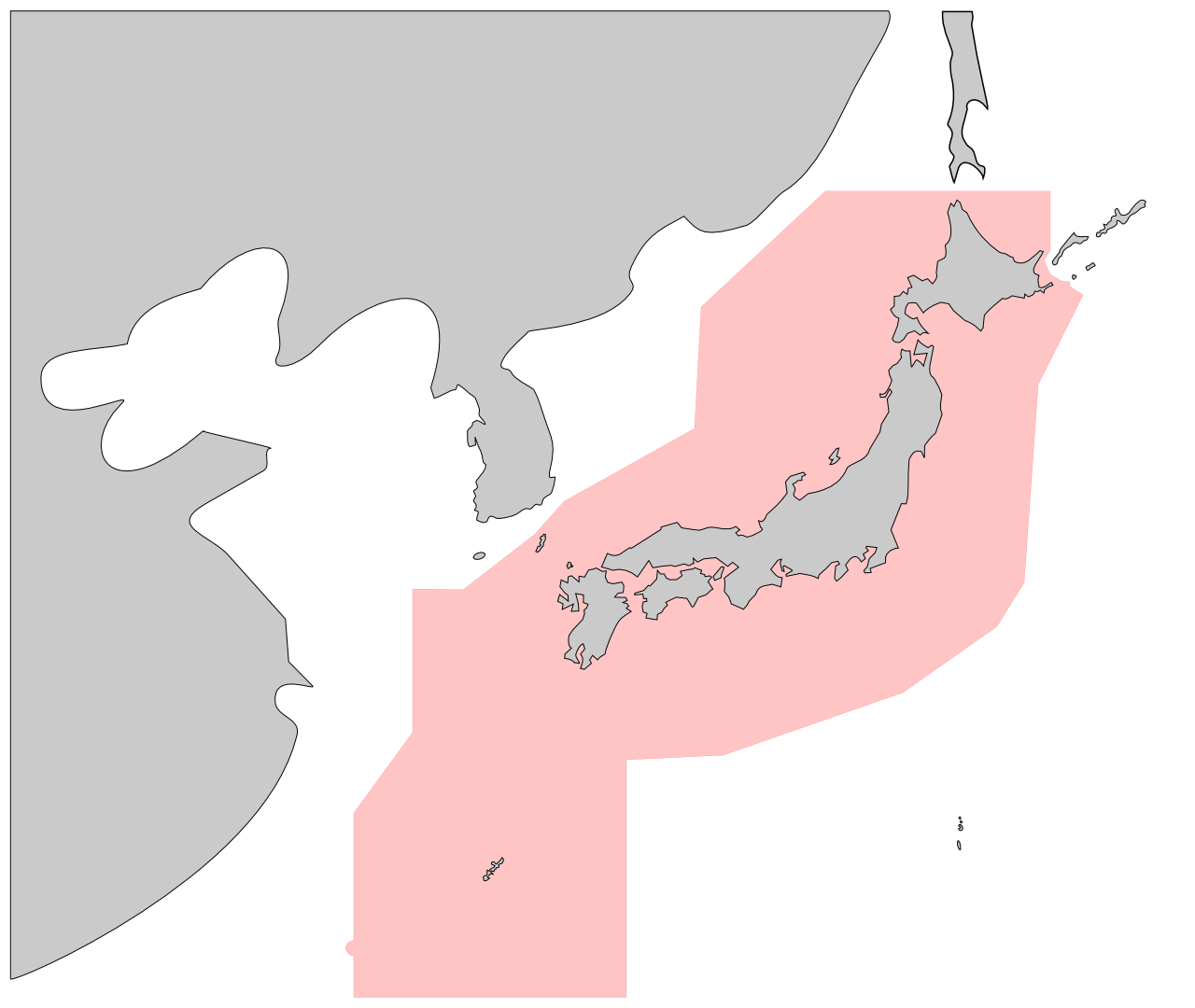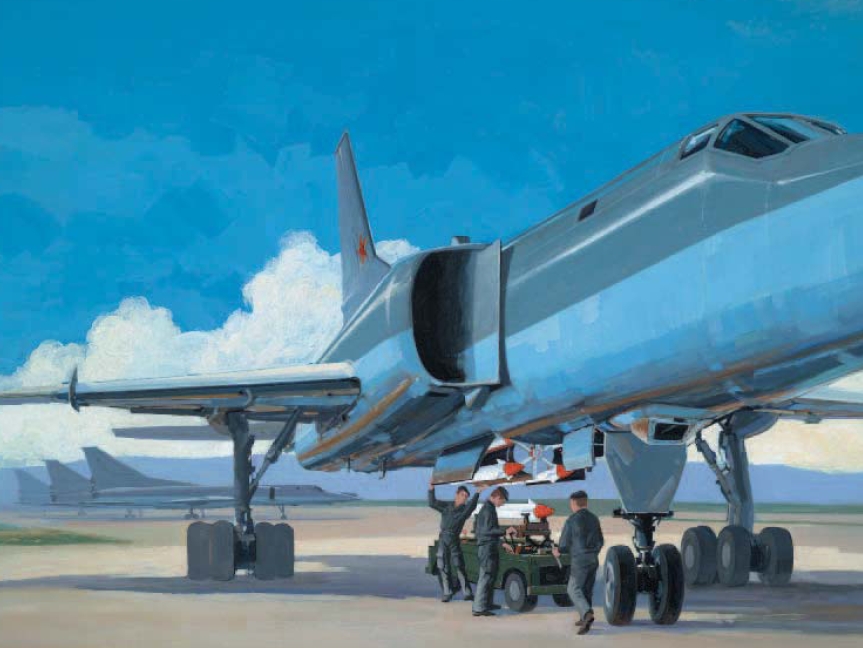|
Tokyo Express (flights)
The is a term for regular flights by Soviet (and later Russian) military aircraft past Japan. They sometimes involve violations of Japanese airspace and have often been intercepted by fighter aircraft of the Japan Air Self-Defense Force. During the Cold War the flights tended to take place along the Sea of Japan side of the country. During the Cold War Tupolev Tu-16, Tupolev Tu-95 and Myasishchev M-4 aircraft were used. Some of them were transiting to or from Cam Ranh Base in southern Vietnam. The Soviet Union started using the base in 1979. After the Cold War ended Russia dramatically reduced its flights and stopped using Cam Ranh base. However, from 2007 Russia re-started regular flights, which now often take place on the Pacific Ocean side of Japan. In this second iteration, Tupolev Tu-22M, Tupolev Tu-95 and Tupolev Tu-142 aircraft are used. As of 2015 Russian aircraft have begun using Cam Ranh Base again, including for Il-78 tankers to support bomber flights in the Pacific. ... [...More Info...] [...Related Items...] OR: [Wikipedia] [Google] [Baidu] |
Violations Of Japanese Airspace
Violations of Japanese airspace have occurred on a number of occasions. There have been 39 cases from 1967 to 2017. The vast majority have involved Soviet aircraft during the Cold War, or Russian aircraft afterwards. There have been several prominent cases of airspace violations. * Viktor Belenko MiG-25 defection (September 6, 1976) * Soviet Tu-16 violation of airspace over Okinawa (December 9, 1987) In addition to actual violations there are many cases of foreign aircraft skirting Japanese airspace or entering Japan's Air Defense Identification Zone. In 2016 fighter squadrons of the Japan Air Self-Defense Force (JASDF) aircraft launched 851 times to intercept Chinese aircraft and 301 times in response to Russian aircraft. [...More Info...] [...Related Items...] OR: [Wikipedia] [Google] [Baidu] |
Stars And Stripes (newspaper)
''Stars and Stripes'' is a daily American military newspaper reporting on matters concerning the members of the United States Armed Forces and their communities, with an emphasis on those serving outside the United States. It operates from inside the Department of Defense, but is editorially separate from it, and its First Amendment protection is safeguarded by the United States Congress to whom an independent ombudsman, who serves the readers' interests, regularly reports. As well as a website, ''Stars and Stripes'' publishes four daily print editions for U.S. military service members serving overseas; these European, Middle Eastern, Japanese, and South Korean editions are also available as free downloads in electronic format, and there are also seven digital editions. The newspaper has its headquarters in Washington, D.C. History Creation On November 9, 1861, during the Civil War, soldiers of the 11th, 18th, and 29th Illinois Regiments set up camp in the Missouri city of ... [...More Info...] [...Related Items...] OR: [Wikipedia] [Google] [Baidu] |
Aviation In The Soviet Union
Aviation includes the activities surrounding mechanical flight and the aircraft industry. ''Aircraft'' includes fixed-wing and rotary-wing types, morphable wings, wing-less lifting bodies, as well as lighter-than-air craft such as hot air balloons and airships. Aviation began in the 18th century with the development of the hot air balloon, an apparatus capable of atmospheric displacement through buoyancy. Some of the most significant advancements in aviation technology came with the controlled gliding flying of Otto Lilienthal in 1896; then a large step in significance came with the construction of the first powered airplane by the Wright brothers in the early 1900s. Since that time, aviation has been technologically revolutionized by the introduction of the jet which permitted a major form of transport throughout the world. Etymology The word ''aviation'' was coined by the French writer and former naval officer Gabriel La Landelle in 1863. He derived the term from the v ... [...More Info...] [...Related Items...] OR: [Wikipedia] [Google] [Baidu] |
Russian Naval Aviation
The Russian Naval Aviation ( rus, Авиация Военно-морского флота России, r=Aviatsiya Voenno-morskovo Flota Rossii) is the air arm of the Russian Navy, a successor of Soviet Naval Aviation. The Russian Navy is divided into four fleets and one flotilla: Northern Fleet, Pacific Fleet, Baltic Fleet, Black Sea Fleet, and Caspian Flotilla. The air forces of the largest and most important fleets, the Northern and Pacific fleets, operate long range Tu-142 anti-submarine warfare (ASW) aircraft, Il-38 medium-range ASW aircraft, and Ka-27 shipborne ASW and search-and-rescue (SAR) helicopters. Formations operating supersonic Tu-22M3 bombers were transferred to the Russian Air Force's Long Range Aviation in 2011. The relatively small fleets, the Baltic and Black Sea, currently have only tactical Su-24 bombers and ASW helicopters in service. The small Caspian Flotilla operates An-26 and Mi-8 transports, Ka-27PS rescue helicopters, as well as some Ka-29 and ... [...More Info...] [...Related Items...] OR: [Wikipedia] [Google] [Baidu] |
Soviet Air Force
The Soviet Air Forces ( rus, Военно-воздушные силы, r=Voyenno-vozdushnyye sily, VVS; literally "Military Air Forces") were one of the air forces of the Soviet Union. The other was the Soviet Air Defence Forces. The Air Forces were formed from components of the Imperial Russian Air Service in 1917, and faced their greatest test during World War II. The groups were also involved in the Korean War, and dissolved along with the Soviet Union itself in 1991–92. Former Soviet Air Forces' assets were subsequently divided into several air forces of former Soviet republics, including the new Russian Air Force. "March of the Pilots" was its song. Origins The ''All-Russia Collegium for Direction of the Air Forces of the Old Army'' (translation is uncertain) was formed on 20 December 1917. This was a Bolshevik aerial headquarters initially led by Konstantin Akashev. Along with a general postwar military reorganisation, the collegium was reconstituted as the "Workers' an ... [...More Info...] [...Related Items...] OR: [Wikipedia] [Google] [Baidu] |
Russian Air Force
" Air March" , mascot = , anniversaries = 12 August , equipment = , equipment_label = , battles = , decorations = , battle_honours = , battle_honours_label = , flying_hours = , website = , commander1 = President Vladimir Putin , commander1_label = Supreme Commander-in-Chief of the Russian Defence Forces , commander2 = Army General Sergei Surovikin , commander2_label = Commander-in-Chief of the Aerospace Forces , commander3 = Lieutenant general , commander3_label = Commander-in-Chief of the Russian Air Force , notable_commanders = , identification_symbol = , identification_symbol_label = Flag , identification_symbol_2 = , identification_symbol_4 ... [...More Info...] [...Related Items...] OR: [Wikipedia] [Google] [Baidu] |
Violations Of Japanese Airspace
Violations of Japanese airspace have occurred on a number of occasions. There have been 39 cases from 1967 to 2017. The vast majority have involved Soviet aircraft during the Cold War, or Russian aircraft afterwards. There have been several prominent cases of airspace violations. * Viktor Belenko MiG-25 defection (September 6, 1976) * Soviet Tu-16 violation of airspace over Okinawa (December 9, 1987) In addition to actual violations there are many cases of foreign aircraft skirting Japanese airspace or entering Japan's Air Defense Identification Zone. In 2016 fighter squadrons of the Japan Air Self-Defense Force (JASDF) aircraft launched 851 times to intercept Chinese aircraft and 301 times in response to Russian aircraft. [...More Info...] [...Related Items...] OR: [Wikipedia] [Google] [Baidu] |
Ilyushin Il-78
The Ilyushin Il-78 (russian: Илью́шин Ил-78; NATO reporting name Midas) is a Soviet/Russian four-engined aerial refueling tanker based on the Il-76 strategic airlifter. Design and development The Soviet Union's first dedicated tanker aircraft were variants of preexisting bombers, like the Tupolev Tu-16 and Myasishchev M-4. Their performance was deemed insufficient, especially so since new bomber models were slated to enter service (the Tupolev Tu-22M and the Tupolev Tu-160). In 1968, the development of a brand-new tanker started, taking the Ilyushin Il-76 as a basis. However, its performances were insufficient for use as a tanker: it could only transfer less than 10 tonnes of fuel to other aircraft. Instead of the basic Il-76, the improved Il-76MD version was chosen as the basis for the new tanker, named Il-78, thanks to its higher fuel capacity. The Il-78 tanker was developed and designed in the Ilyushin Aviation Complex in the Soviet Union. The Il-78 made its ... [...More Info...] [...Related Items...] OR: [Wikipedia] [Google] [Baidu] |
Tupolev Tu-142
The Tupolev Tu-142 (russian: Туполев Ту-142; NATO reporting name: Bear F/J) is a Soviet/Russian maritime reconnaissance and anti-submarine warfare (ASW) aircraft derived from the Tu-95 turboprop strategic bomber. A specialised communications variant designated ''Tu-142MR'' was tasked with long-range communications duties with Soviet ballistic missile submarines. The Tu-142 was designed by the Tupolev design bureau, and manufactured by the Kuibyshev Aviation and Taganrog Machinery Plants from 1968 to 1994. Formerly operated by the Soviet Navy and Ukrainian Air Force, the Tu-142 currently serves with the Russian Navy. Developed in response to the American Polaris programme, the Tu-142 grew out of the need for a viable Soviet ASW platform. It succeeded the failed Tu-95PLO project, Tupolev's first attempt at modifying the Tu-95 for maritime use. The Tu-142 differed from the Tu-95 in having a stretched fuselage to accommodate specialised equipment for its ASW and survei ... [...More Info...] [...Related Items...] OR: [Wikipedia] [Google] [Baidu] |
Tupolev Tu-22M
The Tupolev Tu-22M (russian: Туполев Ту-22М; NATO reporting name: Backfire) is a supersonic, variable-sweep wing, long-range strategic and maritime strike bomber developed by the Tupolev, Tupolev Design Bureau in the 1960s. According to some sources, the bomber was believed to be designated Tu-26 at one time. During the Cold War, the Tu-22M was operated by the Soviet Air Forces (VVS) in a missile carrier strategic bombing role, and by the Soviet Naval Aviation (''Aviatsiya Voyenno-Morskogo Flota'', AVMF) in a long-range maritime anti-shipping role. As of 2021, before the 2022 Russian invasion of Ukraine, there were 66 of the aircraft in service. Development In 1962, after the introduction of the Tupolev Tu-22, it became increasingly clear that the aircraft was inadequate in its role as a bomber. In addition to widespread unserviceability and maintenance problems, the Tu-22's handling characteristics proved to be dangerous. Its landing speed was greater than previ ... [...More Info...] [...Related Items...] OR: [Wikipedia] [Google] [Baidu] |
Pacific Ocean
The Pacific Ocean is the largest and deepest of Earth's five oceanic divisions. It extends from the Arctic Ocean in the north to the Southern Ocean (or, depending on definition, to Antarctica) in the south, and is bounded by the continents of Asia and Oceania in the west and the Americas in the east. At in area (as defined with a southern Antarctic border), this largest division of the World Ocean—and, in turn, the hydrosphere—covers about 46% of Earth's water surface and about 32% of its total surface area, larger than Earth's entire land area combined .Pacific Ocean . '' Britannica Concise.'' 2008: Encyclopædia Britannica, Inc. The centers of both the |






.jpg)